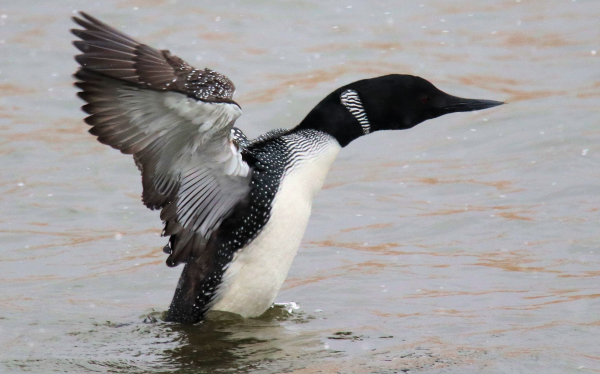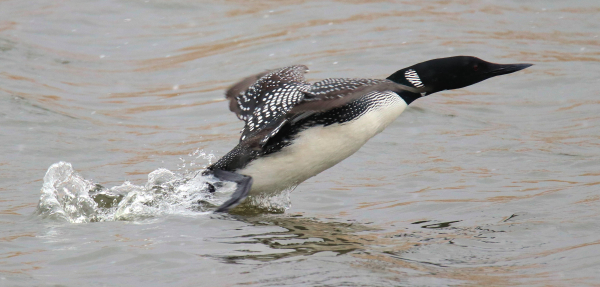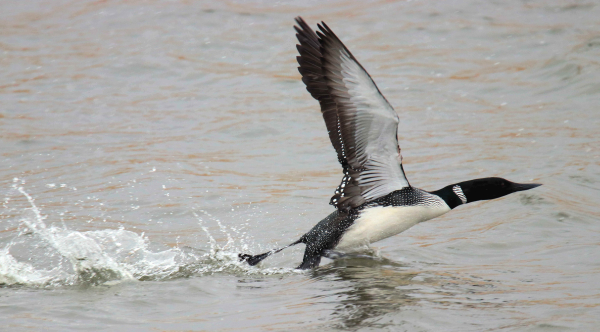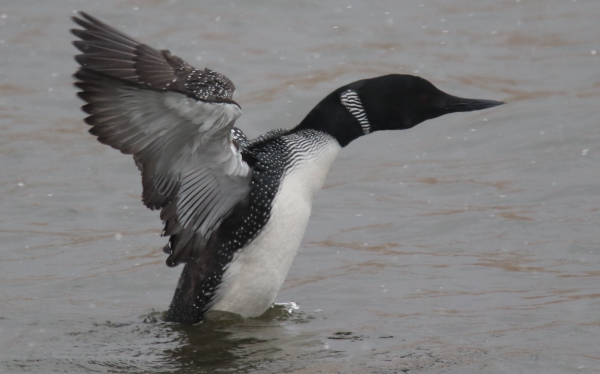It’s always exciting when I’m birding solo and catch myself saying “WoW” out loud, cuz that indicates a super-surprise sighting. That's what happened Thursday afternoon when I caught sight of Common Loon next to the road in the corner of a familiar marsh 6 miles south of my office. Double Wow! I kept driving a bit before making a safe U-turn, double-checking my camera settings under the current conditions, which were pretty terrible for photography – but there was a loon in full alternate plumage close to the shore!
Easing up to the location where the loon was, there was no sign of it; but I continued inching forward, then saw it pop into view half-way across the smallish wetland. The loon dived again, and again, as it appeared to be on the hunt for aquatic food. While it was below the surface, I edged forward to what I hoped would be the best vantage point and began to wait for the loon to work its way back in my direction – hopefully.

This was only the third Common Loon I’ve seen in this area during many springs and falls in south-central North Dakota. Although these special loons are the state bird for neighboring Minnesota, loons just aren’t normally found in the open plains – about 160 miles west of the nearest loon lake – so this was a special bird and a special opportunity; maybe.
The big melt was opening more and more area marshes last week, and edges of larger wetlands, although lakes remained icebound. That probably worked into my luck to find the loon on a smallish wetland, which also attracted 10 Buffleheads (2 females and 8 drakes) a couple Pied-billed Grebes, a pair of Giant Canada Geese, and a bit later a small flock of Redheads landed for a while. After some diving and, hopefully, some eating time, the loon switched to preening, although it was mostly oiling its feathers top to bottom, side to side.
Although it was almost on the opposite side of the marsh, I could still get some photos when the loon stopped preening to bathe, ruffling its feathers and wings in the water, then rising up to shake the water off, its bill pointing high at the sky while flapping its wings. The oiling, bathing, and shaking continued through a couple more cycles, but the weather was pretty terrible for photography. Thick low clouds that became almost fog-like at times were the opposite of the afternoon sunlight I would have wished for – and it was snowing, with the north-northwest wind blowing ever-bigger flakes across the scene. But that may have been the reason the loon stopped after its overnight migration flight, the reason why it was slumming in this little pond.

At one point the loon’s position incited one of the geese, probably the male, to approach it, and when the loon didn’t back away, I poised myself for what I thought might be an eruptive interaction, but the goose wasn’t aggressive and the loon moved away a bit to resume its preening. Presumably after finishing, the loon began working its way in my direction, diving a couple times in the process, presumably on the hunt again. But when it began getting into my preferred range for photography, it simply kept swimming toward the southeast corner of the marsh, where I first observed it.
There it turned around, facing into the wind, and raised up to flap its wings a couple times, providing an excellent opportunity to photograph the sequence – wings back, forward, back; head high. Then it settled back down to provide some nice resting/swimming images for a moment – then it was off, launched up and forward simultaneously while extending its wings to its sided in broad sweeping flaps as its feet pattered forward to push the loon above the water. Obviously, I was photographing the take-off, holding down the shutter button to take a rapid sequence of photos.
Of course, I was sorry to see the loon leave, but I had spent more than a half-hour with rare bird, waited out my opportunity to photograph it at closer quarters, then made the most of its considerable effort to take flight. The loon slowly elevated into the snowy wind and after getting about 25 feet high, it curved back to use the wind to help propel it directly south toward a larger shallow marsh just over a tall hill. I tried not to lose sight of the loon, but after it passed behind the hill top, I couldn’t relocate it. The loon may have landed at the far west side of that larger marsh, or perhaps it continued to another open-water option.

The Gray Reality
What fun that was; the observations, the potential for photos, the eventual photos, and just to be in sight of a Common Loon near home, at fairly close quarters in the end. I took some fine photos, but let’s not forget the photo conditions were about as far from optimum as they could have been. Obviously, a thick low cloud ceiling and blowing snow is not what anyone would order for photographing such a special bird under all the other circumstances. I did what I could, such as before leaving home I switched my ISO setting from 400 to 800, making the other camera settings more light-sensitive and hopefully providing adequately fast shutter speeds.
Even so, when I double-checked my settings after seeing the loon, I didn’t expect to photograph any action – just a couple photos of the loon swimming. But the loon provided some exceptional action photo opportunities, and I was surprised at the fast shutter speeds created using the ISO 800. I had also reduced my aperture to f-6 to facilitate a faster shutter speed, figuring I didn’t need a very wide area in focus if the loon was merely swimming on the water surface. The f-6 aperture allowed for a shutter speed of 1/1,000 of a second, fast enough to stop most avian action. It all worked out as well as could be hoped for really under the prevailing conditions.
When I first looked at the resulting loon photographs, I was pretty impressed with the results. The images were sharp and detailed, but the contrast and colors were very dull; but they were at least documentary. Even so, the loon photos had potential beyond what their initial images showed. After cropping the first selected photo to eliminate extraneous water surrounding the loon, and thereby enlarging the loon in the photo frame, I was interested in doing a bit of experimenting to see if the image could be improved.

Using my photo editing program, Corel’s Paintshop Pro, on the top menu I clicked on the word “Adjust.” Then on the resulting scroll-down menu, I tried the first option, listed as “One Step Photo Fix.” I clicked it, and Wow, it transformed a photo that was mostly gray and black to enlighten appropriate grays to white on the loon, some gray highlights in the water showed some tan coloration, and it made the black shades blacker, adding to the overall contrast and coloration to show more accurate colors of the loon and the water – Double-Wow!
I clicked on an arrow on the menu that returned my view to the original cropped photo, and back to the “fixed” image, then back again. Comparing the remarkable transformation that brightened the shades of the color photograph while it added to the contrast and sharpness of the “fixed” image. It was equally surprising to see that the original photo looked like a black-and-white photo – rather than a color photograph. The transformation was really amazing!
The Transformation
If you read the Bird Photography feature regularly, you know I am all about photographing when there is ample sunlight from the right angle – usually I don’t even go birding when it’s cloudy so any photos I take have the best possible chance of success. And you know that I don’t profess editing photos beyond simple cropping. But knowing I had some fairly good photos, knowing their shortcomings but imagining their potential, it was worth a try – and it worked – worked well!

Now that wasn’t the first time I’ve resorted to using the “One Step Photo Fix” option, but it produced a best case scenario in this case. Trying the “One Step Photo Fix” on other photos has resulted in mixed success and more often than not the resulting edited image doesn’t turn out very well. But in this case, it was the closest thing to producing magic. So why look for excuses for using this magic fix to weather-compromised (light-compromised) photos? Instead, I’ll just share the process with you, and show an example of the “magic” transformation between an original and a fixed image, and revel at the payoff. I hope you agree that it’s a successful and useful fix.
Birding is great fun, adding moments of excitement and happy memories to our lives, but I’m convinced that bird photography also adds a higher level of appreciation to our birding experiences that include tangible photographs to enjoy and share. We all learn and improve while using the equipment and techniques with ever better results. Spring may be the best season for improving the photos we take, so don’t hesitate to try something new and hope for the best – ya never know. And don’t forget, there’s an important level of Luck involved in bird photography. Good Luck!
Article and photographs by Paul Konrad
Share your bird photos and birding experiences at editorstbw2@gmail.com